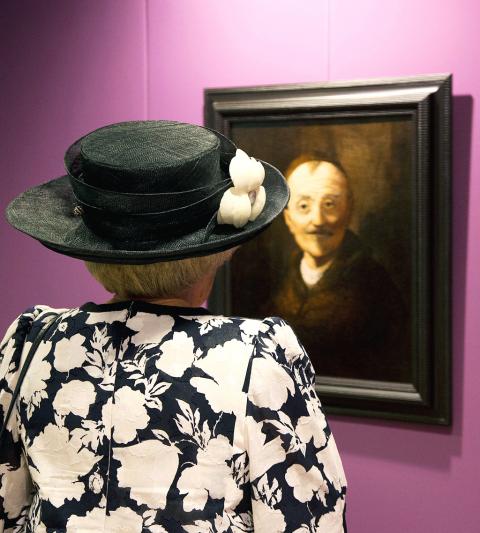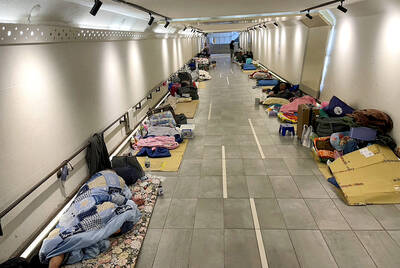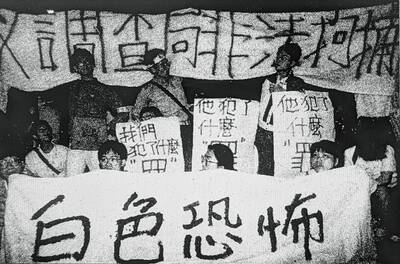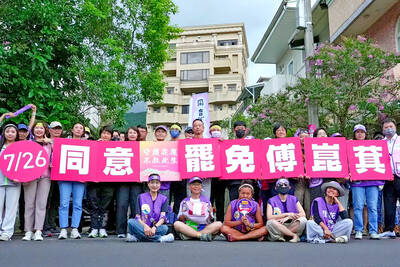Bargain hunting online? How about an original Rembrandt for US$900 (“you can clearly tell its age by the paper,” the seller of this etching attests), or a signed piece in ink by Matisse for US$1,250. (The artist’s work is, the online seller notes, “radical and unprecedented in the history of Western art.”)
Yes, Sotheby’s can command more than US$100 million for a Picasso at auction. But shoppers on the Web can find an “original” painting by that master for a mere US$450 — less than a pair of designer shoes.
Every day works labeled “original” and “authentic” and attributed to titans of the art world are offered at closeout prices by online galleries and auction sites. And every day people buy them.

Photo: EPA
That these works are sometimes fake or misleadingly labeled is no surprise to art experts and to foundations that monitor online art sales. But fraud has saturated certain sectors of the art market, experts say.
“In every country that I visit, even Abu Dhabi, I’m approached by artists or estates who are desperate about the fake situation,” said Veronique Wiesinger, the director and senior curator of the Alberto and Annette Giacometti Foundation in Paris. “We counted the other day 2,005 fake Giacometti sculptures for sale” on just one Web site, she added.
Many reputable online sellers, of course, deliver precisely what they advertise. “There is a lot of buying online, and most people are satisfied,” said Alan Bamberger, an art consultant and appraiser.
Over the last few years the Internet has broadened the art market far beyond the exclusivity and opaque jargon of its moneyed enclaves and has helped turn the slogan “art for everyone” into reality. But it has also become a sort of bazaar, where shoppers of varying sophistication routinely encounter all degrees of flimflammery, from the schemes of experienced grifters to the innocent mistakes of the unwitting and naive. A recent study by statisticians at George Washington University and the University of California, Irvine, estimated that as many as 91 percent of the drawings and small sculptures sold online through eBay as the work of the artist Henry Moore were fake.
The Giacometti Foundation and the Picasso estate view the problem of bogus art sales as so acute that this year they helped found a new association, the International Union of Modern and Contemporary Masters, to promote legal protections “against the circulation of counterfeit works of art.”
Art is legitimately sold on the Internet at a wide spectrum of sites, including those run by individual artists; established galleries that have expanded online; and new galleries that represent the work of emerging artists. A by-product of so many reputable businesses’ selling art through the Web these days, experts said, is that it has become easier for those that are less reputable to pass off forgeries.
Fakes can take many forms. Most common are unauthorized reproductions that violate an artist’s copyright or trademark. Other times the reproduction has been authorized, but someone adds the artist’s signature — either forged or copied — to transform a cheap poster into an expensive “signed” limited edition.
Finally, there are out-and-out forgeries sold as the work of an artist.
Last month David Crespo, the owner of a gallery in Madison, Connecticut, was charged with selling fake Picasso drawings that he had been duped into buying on the Internet years earlier. Crespo had paid nearly US$50,000 for a supposed set of Picasso drawings from a seller known as Collectart4less, according to court papers. After discovering that they were reproductions, he sold several to unsuspecting buyers for hundreds of thousands of dollars, prosecutors say, providing false documents attesting to their authenticity and provenance. (Crespo has pleaded not guilty to the charges.)
Online art is often accompanied by a “certificate of authenticity” or a registry certificate. But these are generally not worth much as a measure of authenticity, experts say, unless they have been signed by an artist or his or her authorized dealer.
The registry certificates are often sold by online businesses that give out certificates attesting that someone has registered a work — not that the art is authentic. At one site, for example, National Fine Arts Title Registry, anyone who fills out a form and pays US$10 can print out a certificate minutes later.
Trawling eBay and other Web sites for fakes is a daily activity at the Calder Foundation in New York, said its chairman, Alexander S.C. Rower, who is Alexander Calder’s grandson. At the foundation recently, Rower explained the myriad ways that buyers and sellers were deceived. Using an iPad, he pointed to an image of a 12-inch-high sculpture of an elephant balancing on its upraised trunk a wire with a red sun on one end, and a crescent and a yellow half-star on the other. “This is one of the ugliest things I’ve ever seen in my entire life,” Rower said.
Several galleries around the world advertise it as a limited edition by Calder, although the artist had nothing to do with it.
Employees of eBay do not vet merchandise sold on its site, though the company does investigate complaints of counterfeits, said Amanda Christine Miller, a spokeswoman. Rower said that eBay was prompt in removing fakes.
James Stow, who buys and sells art online, using his Florida kitchen as the packing and shipping department, frequently posts articles on his Facebook page schooling amateur collectors on how to avoid being swindled. A recent one was titled “Buying Old Masters Prints-Etchings on the Internet? Are You Kidding ... ”
He is not.
Among the art and collectibles Stow recently listed on eBay was a “Rembrandt The Hog Etching” for US$249.99.
How could it be so inexpensive? Stow said the etching had been trimmed so that there was no mark from the original copper plate, a distinguishing feature that many experts use to authenticate a work.
And how does he know it is real? “I looked it up in the catalogue raisonne,” the definitive compilation of an artist’s work, Stow said.
He added that he relied on his 20 years of experience to distinguish between a genuine etching and a faked copy.
(Etchings printed from Rembrandt’s original copper plates vary enormously in quality and value, depending on whether they were made more recently, using worn plates, or printed during the artist’s lifetime; the older ones can fetch more than US$1,000,000. Stow is selling another Rembrandt etching for US$2,600.)
For the caretakers of estates, protecting an artist’s legacy can be expensive. Wiesinger said the Giacometti Foundation spent more than 40 percent of its operating budget in 2011 on tracking fakes, up from 25 percent in 2004. And the foundation last year began awarding US$12,000 to institutions or individuals who bring public attention to the prevalence of fakes and forgeries.
In Rower’s view, sellers, frequently hobbyists, are often as uninformed as buyers. He noticed, for example, that people were mistakenly selling teardrop-shaped candy bowls as Calders because they saw on them the letters “C” and “A,” in a version of Calder’s characteristic initialing. It turns out the “C” and “A” stand for “copper alloy.”
You would think that the reputations of those who repeatedly sell fakes online would suffer. But Bamberger, who runs the Web site artbusiness.com, said consumers generally did not base their assessments of sellers on the authenticity of the art, because they may not know the difference. Rather, customers tend to look at whether a seller packed carefully, shipped on time and answered questions promptly.
Do those three things well, Bamberger said, and chances are that people buying art on the Internet will give you high marks.
Barry Werbin, an art lawyer in New York whose father was a fine-art dealer, says customers who buy art online are out of their minds. Buying art in person, with expertise, is hard enough, he said. But people hear about astonishing finds at garage sales or watch television series like Antiques Roadshow and feel that same kind of good fortune can strike them online.
“It gets everyone riled up and makes for great television,” he said, “but such finds are very far and few between.”
Of course, some buyers may be fully aware that they are buying fakes, ones that look delightfully realistic and spruce up their homes. Bamberger said many people who bought art over the Internet were, at heart, bargain hunters, delighted to think they were getting a deal.
“If you’re going to buy a fake and you believe it’s real,” he said, “then you’re going to be happy with it.”

From the last quarter of 2001, research shows that real housing prices nearly tripled (before a 2012 law to enforce housing price registration, researchers tracked a few large real estate firms to estimate housing price behavior). Incomes have not kept pace, though this has not yet led to defaults. Instead, an increasing chunk of household income goes to mortgage payments. This suggests that even if incomes grow, the mortgage squeeze will still make voters feel like their paychecks won’t stretch to cover expenses. The housing price rises in the last two decades are now driving higher rents. The rental market

July 21 to July 27 If the “Taiwan Independence Association” (TIA) incident had happened four years earlier, it probably wouldn’t have caused much of an uproar. But the arrest of four young suspected independence activists in the early hours of May 9, 1991, sparked outrage, with many denouncing it as a return to the White Terror — a time when anyone could be detained for suspected seditious activity. Not only had martial law been lifted in 1987, just days earlier on May 1, the government had abolished the Temporary Provisions Effective During the Period of National Mobilization for Suppression of the Communist

When life gives you trees, make paper. That was one of the first thoughts to cross my mind as I explored what’s now called Chung Hsing Cultural and Creative Park (中興文化創意園區, CHCCP) in Yilan County’s Wujie Township (五結). Northeast Taiwan boasts an abundance of forest resources. Yilan County is home to both Taipingshan National Forest Recreation Area (太平山國家森林遊樂區) — by far the largest reserve of its kind in the country — and Makauy Ecological Park (馬告生態園區, see “Towering trees and a tranquil lake” in the May 13, 2022 edition of this newspaper). So it was inevitable that industrial-scale paper making would

Hualien lawmaker Fu Kun-chi (傅?萁) is the prime target of the recall campaigns. They want to bring him and everything he represents crashing down. This is an existential test for Fu and a critical symbolic test for the campaigners. It is also a crucial test for both the Chinese Nationalist Party (KMT) and a personal one for party Chairman Eric Chu (朱立倫). Why is Fu such a lightning rod? LOCAL LORD At the dawn of the 2020s, Fu, running as an independent candidate, beat incumbent Democratic Progressive Party (DPP) lawmaker Hsiao Bi-khim (蕭美琴) and a KMT candidate to return to the legislature representing